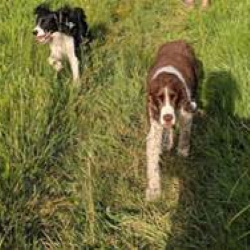Bees and Dogs should not play together!
Our black and white Springer Chauncey likes to swim as much as he likes to chase anything that flies including bees and when doing the later, it scares me to death!
When your dog tries to bite bees, yellow jackets, hornet and wasps, they are usually stung in their mouth or throat. If this occurs, it can be dangerous as the swelling can block your dog’s airways. See the above picture of this next to the bee. (Poor guy)
If your dog is allergic, the sting(s)can lead to anaphylactic shock which can be deadly. If this is the case the dog will vomit immediately(5-10 minutes after being stung, have difficulty breathing and or have gums that grow pale.
Also, multiple stings can be fatal. Dogs need to be trained to listen to you when you call him out of harms way! (not always easy, I know!)
If you dog is stung. Go your vet directly if your dog has trouble breathing and lots of swelling. Regardless call your vet.
If your dog gets stung, scrape out the stinger. Apply a paste of baking soda and water, then ice the area. An OTC antihistamine, in the right dose for their weight, may also be needed (your vet should prescribe the right amount).
To avoid hive building and places where these insects like to nest-caulk cracks around windows. Use long range non-toxic insecticides to rid yourself of these burrowing stinging insects.





